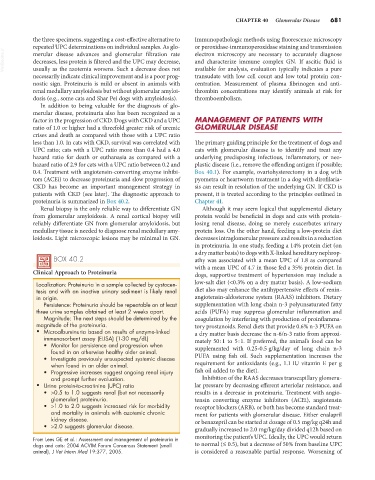Page 709 - Small Animal Internal Medicine, 6th Edition
P. 709
CHAPTER 40 Glomerular Disease 681
the three specimens, suggesting a cost-effective alternative to Immunopathologic methods using fluorescence microscopy
repeated UPC determinations on individual samples. As glo- or peroxidase-immunoperoxidase staining and transmission
VetBooks.ir merular disease advances and glomerular filtration rate electron microscopy are necessary to accurately diagnose
and characterize immune complex GN. If ascitic fluid is
decreases, less protein is filtered and the UPC may decrease,
usually as the azotemia worsens. Such a decrease does not
transudate with low cell count and low total protein con-
necessarily indicate clinical improvement and is a poor prog- available for analysis, evaluation typically indicates a pure
nostic sign. Proteinuria is mild or absent in animals with centration. Measurement of plasma fibrinogen and anti-
renal medullary amyloidosis but without glomerular amyloi- thrombin concentrations may identify animals at risk for
dosis (e.g., some cats and Shar Pei dogs with amyloidosis). thromboembolism.
In addition to being valuable for the diagnosis of glo-
merular disease, proteinuria also has been recognized as a
factor in the progression of CKD. Dogs with CKD and a UPC MANAGEMENT OF PATIENTS WITH
ratio of 1.0 or higher had a threefold greater risk of uremic GLOMERULAR DISEASE
crises and death as compared with those with a UPC ratio
less than 1.0. In cats with CKD, survival was correlated with The primary guiding principle for the treatment of dogs and
UPC ratio; cats with a UPC ratio more than 0.4 had a 4.0 cats with glomerular disease is to identify and treat any
hazard ratio for death or euthanasia as compared with a underlying predisposing infectious, inflammatory, or neo-
hazard ratio of 2.9 for cats with a UPC ratio between 0.2 and plastic disease (i.e., remove the offending antigen if possible;
0.4. Treatment with angiotensin-converting enzyme inhibi- Box 40.1). For example, ovariohysterectomy in a dog with
tors (ACEi) to decrease proteinuria and slow progression of pyometra or heartworm treatment in a dog with dirofilaria-
CKD has become an important management strategy in sis can result in resolution of the underlying GN. If CKD is
patients with CKD (see later). The diagnostic approach to present, it is treated according to the principles outlined in
proteinuria is summarized in Box 40.2. Chapter 41.
Renal biopsy is the only reliable way to differentiate GN Although it may seem logical that supplemental dietary
from glomerular amyloidosis. A renal cortical biopsy will protein would be beneficial in dogs and cats with protein-
reliably differentiate GN from glomerular amyloidosis, but losing renal disease, doing so merely exacerbates urinary
medullary tissue is needed to diagnose renal medullary amy- protein loss. On the other hand, feeding a low-protein diet
loidosis. Light microscopic lesions may be minimal in GN. decreases intraglomerular pressure and results in a reduction
in proteinuria. In one study, feeding a 14% protein diet (on
a dry matter basis) to dogs with X-linked hereditary nephrop-
BOX 40.2 athy was associated with a mean UPC of 1.8 as compared
with a mean UPC of 4.7 in those fed a 35% protein diet. In
Clinical Approach to Proteinuria dogs, supportive treatment of hypertension may include a
Localization: Proteinuria in a sample collected by cystocen- low-salt diet (<0.3% on a dry matter basis). A low-sodium
tesis and with an inactive urinary sediment is likely renal diet also may enhance the antihypertensive effects of renin-
in origin. angiotensin-aldosterone system (RAAS) inhibitors. Dietary
Persistence: Proteinuria should be repeatable on at least supplementation with long chain n-3 polyunsaturated fatty
three urine samples obtained at least 2 weeks apart. acids (PUFA) may suppress glomerular inflammation and
Magnitude: The next steps should be determined by the coagulation by interfering with production of proinflamma-
magnitude of the proteinuria. tory prostanoids. Renal diets that provide 0.6% n-3 PUFA on
• Microalbuminuria based on results of enzyme-linked a dry matter basis decrease the n-6/n-3 ratio from approxi-
immunosorbent assay (ELISA) (1-30 mg/dL) mately 50 : 1 to 5 : 1. If preferred, the animal’s food can be
• Monitor for persistence and progression when
found in an otherwise healthy older animal. supplemented with 0.25-0.5 g/kg/day of long chain n-3
• Investigate previously unsuspected systemic disease PUFA using fish oil. Such supplementation increases the
when found in an older animal. requirement for antioxidants (e.g., 1.1 IU vitamin E per g
• Progressive increases suggest ongoing renal injury fish oil added to the diet).
and prompt further evaluation. Inhibition of the RAAS decreases transcapillary glomeru-
• Urine protein-to-creatinine (UPC) ratio lar pressure by decreasing efferent arteriolar resistance, and
• >0.5 to 1.0 suggests renal (but not necessarily results in a decrease in proteinuria. Treatment with angio-
glomerular) proteinuria. tensin converting enzyme inhibitors (ACEi), angiotensin
• >1.0 to 2.0 suggests increased risk for morbidity receptor blockers (ARB), or both has become standard treat-
and mortality in animals with azotemic chronic ment for patients with glomerular disease. Either enalapril
kidney disease. or benazepril can be started at dosage of 0.5 mg/kg q24h and
• >2.0 suggests glomerular disease.
gradually increased to 2.0 mg/kg/day divided q12h based on
From Lees GE et al.: Assessment and management of proteinuria in monitoring the patient’s UPC. Ideally, the UPC would return
dogs and cats: 2004 ACVIM Forum Consensus Statement (small to normal (≤ 0.5), but a decrease of 50% from baseline UPC
animal), J Vet Intern Med 19:377, 2005. is considered a reasonable partial response. Worsening of

